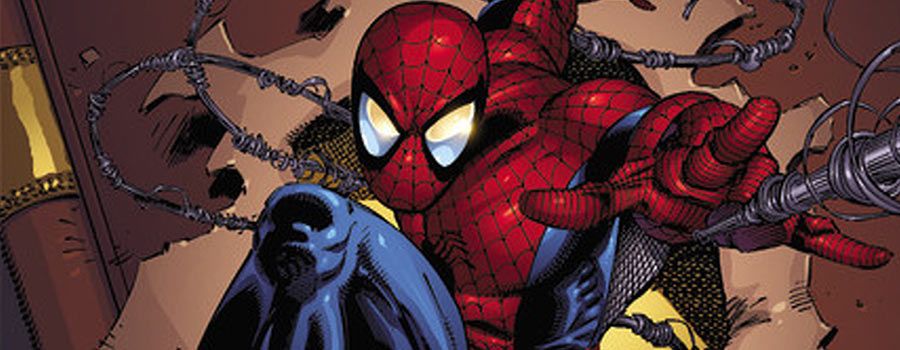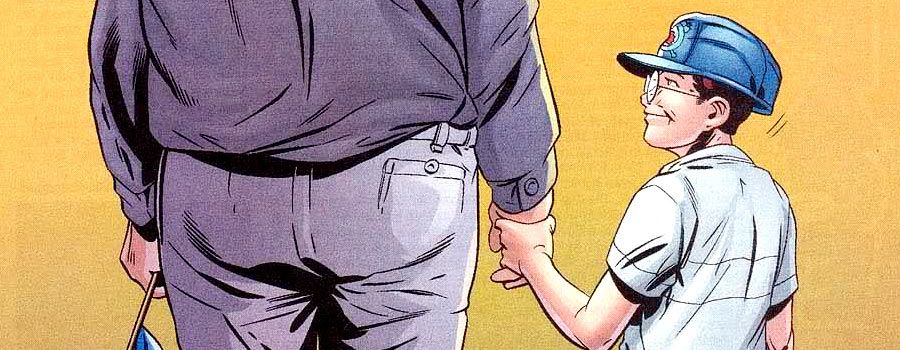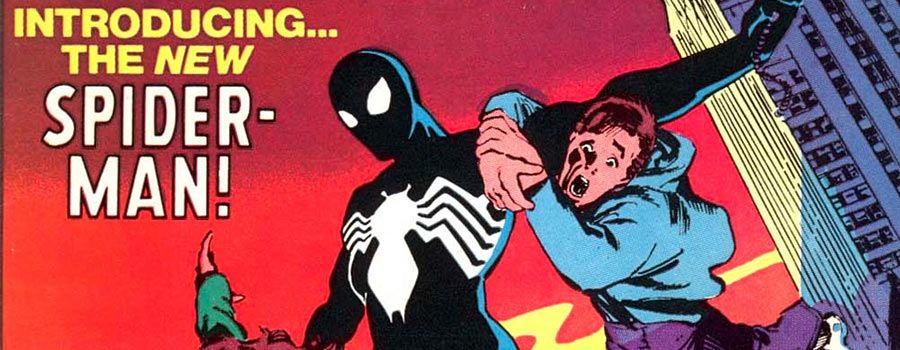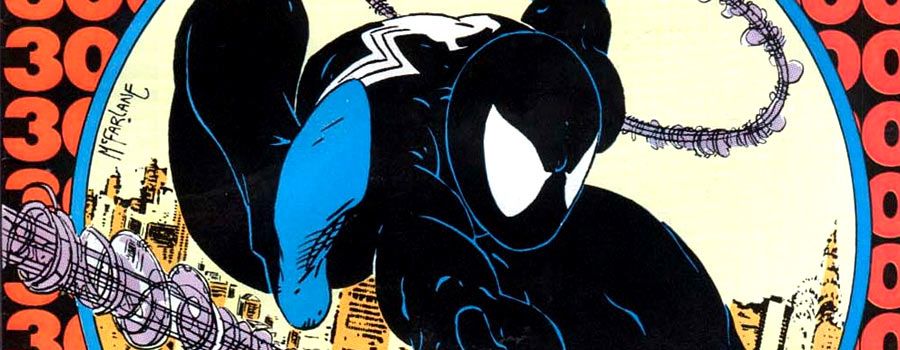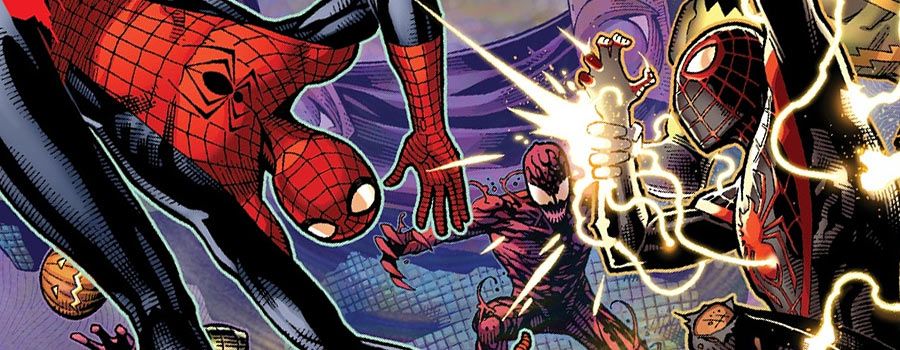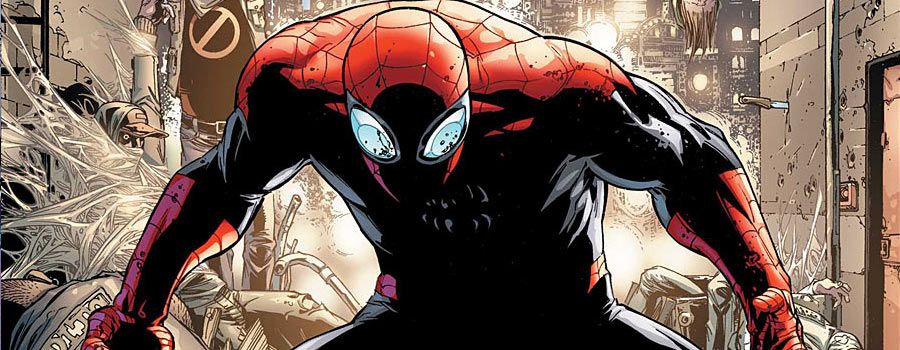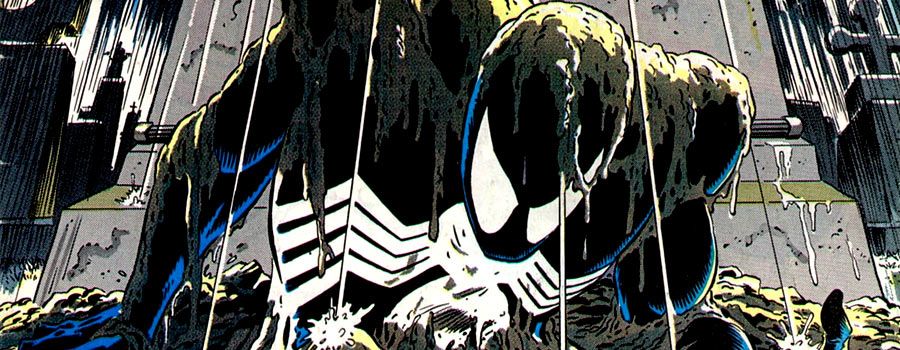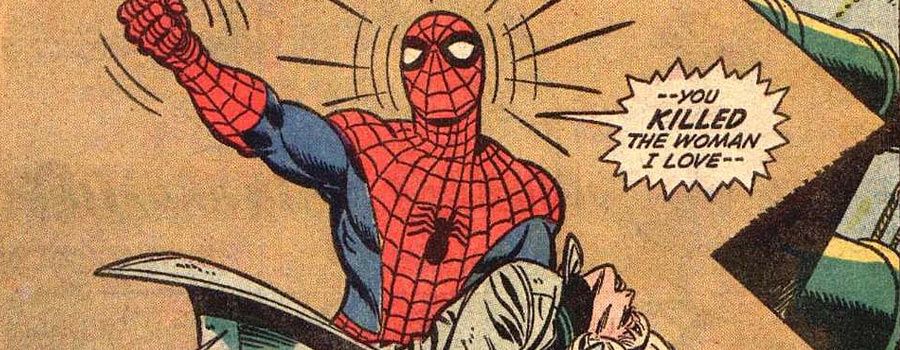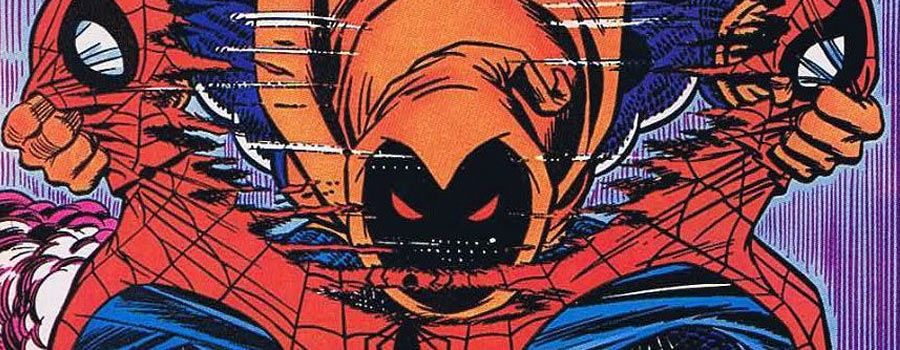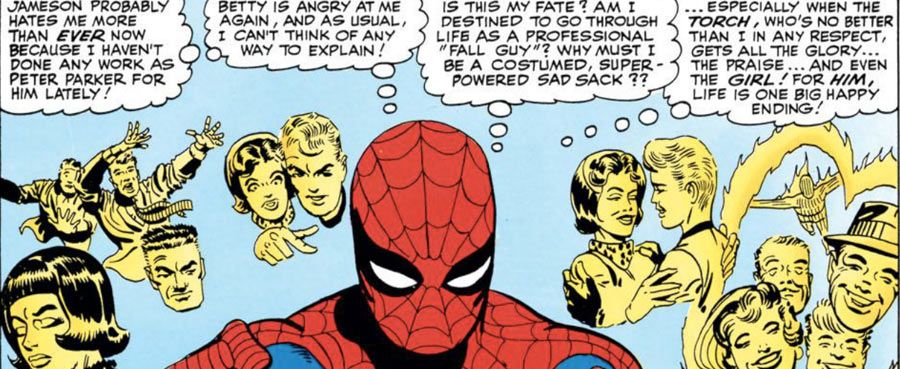It certainly is an exciting time to be a fan of Marvel Comics' Spider-Man. With a new film featuring some of Spidey's greatest foes ready to hit in May, "Superior Spider-Man" achieving great sales success and even greater controversy, the Ultimate Spider-Man animated series airing on Disney XD, and more films on the way including a potentially expanded Spider-film universe from Sony Pictures, it's hard to spin a web without hitting something Spidey related. As Spider-fans look to the future, it is very important no one forgets the great Spider creators that made this Golden Age of all things Parker possible. CBR presents a look at ten of the greatest creators to leave their mark on the rich history of Peter Parker and his alter ego, the Amazing Spider-Man.
10. Kurt Busiek
"Web of Spider-Man" #81-83, "Spider-Man Unlimited" #2-5, "Untold Tales Of Spider-Man" #1-25, "Untold Tales Of Spider-Man '96" "Untold Tales Of Spider-Man '97," "Untold Tales Of Spider-Man: Strange Encounter" #1, "Spider-Man Team-Up" #7
One of the Marvel's most popular and prolific authors of the '90s and 2000s (and still proving he is one of the most innovative voices in comics today with his latest volume of "Astro City" from Vertigo Comics), Kurt Busiek is best known for his work on the Avengers and creation of the Thunderbolts -- but that's not to say his Spider-Man oeuvre should be overlooked. The writer cut his teeth on three capable "Web of Spider-Man" issues in 1991 (one featuring Man Mountain Marko, who doesn't love Man Mountain Marko?), but Busiek really made an impact on Spider-Man history with his 1995 "Untold Tales of Spider-Man" series with artist Pat Olliffe.
"Untold Tales" was an innovate project that took place in between the first twenty-five issues of the Sliver Age "Amazing Spider-Man." Fans got to see the emotional impact some of Spider-Man's earliest battles had on the web-slinger as well as on his friends and family. It was a tribute to Stan Lee and Steve Ditko that did not get bogged down in continuity; instead, it was a loving focus on Peter trying to survive high school while recovering from his first battles with Dr. Octopus, Electro and the Sandman. "Untold Tales" proved there was a market for a high school Spider-Man book, something Marvel would exploit just a few years later with "Ultimate Spider-Man." The book was able to examine the Silver Age stories from multiple point of views, like that of Mary Jane Watson, a character who did not take part in the original Spidey narrative, but would have been present in the surrounding areas of Peter's first battles. Busiek introduced new characters like Scorch, Commanda and Batwing -- all woulda, coulda, shoulda been Silver Age characters introduced in a very modern context. All in all, Busiek pulled off the impossible, creating comics that made the original issues of "Amazing" shine ever brighter while forging his own legacy with Spider-Man. Sadly, "Untold Tales" did not last long, but it was strong enough to put Busiek on this list.
9. Paul Jenkins
"Webspinners: Tales of Spider-Man" #10-12, "Peter Parker: Spider-Man" (vol. 2) #20-41and #44-50, "Spectacular Spider-Man" (vol. 2) #1-22, #27, "Mythos: Spider-Man"
Paul Jenkins has written a variety of characters for both Marvel and DC Comics over the past decade. Some of his career highlights for Marvel include his "Inhumans" maxiseries with Jae Lee and, of course, the seismic "Origin," the book that dared to finally delve into Wolverine's past. Lost with these huge event book was Jenkins' five year run on Spider-Man. Jenkins had a perfect tonal control over Spider-Man with one issue delving into Peter's past relationship with Uncle Ben and the next showcasing hilarious battles with the intentionally super lame villain, Typeface. The Uncle Ben story in particular was one of the greatest comics featuring Peter's inspirational mentor; the entire issue focused on Peter and Ben bonding over their love of the hapless New York Mets. It was quiet, understated and beautiful, a perfect character study of Peter. But Jenkins was able to turn up the volume as well with an incredible Dr. Octopus story, the introduction of Fusion, and a character-defining story featuring the Sandman.
Jenkins had a talent for stripping down and exposing Spidey's villains and supporting cast all the while portraying Peter as a lovable everyman who was every inch the noble hero. This era of Spider-Man's history featured plenty of pathos, so much so that a number of titles starring the once wisecracking Spider-Man, at times, lost that humorous edge that the greates Spider-Man stories have. Not Jenkins, however, who would always break up his serious stories with some very zany ideas, like a pack of aggressive mimes who showed up and caused trouble without explanation. There were no real game changers in Jenkins' run, but there didn't need to be. Instead, his time on Spider-Man will always be defined as a five-year character study of Peter Parker the man, the hero, the legend.
8. Tom DeFalco
"Amazing Spider-Man" #251-285, 407-439, "Amazing Spider-Man Annual" #18, #22-24, '96,'97, Marvel Team-Up #99, #106-107, #109, #138, #140-141, "Spectacular Spider-Man" #215-229, "Spider-Man" #26, "Web of Spider-Man" #128-129, "Web of Scarlet Spider" #1-2, "Webspinners" #17-18, "Spider-Girl" Vol. 1 #0-100, "Amazing Spider-Girl" #1-30, "Amazing Scarlet Spider" #1-2
Hot damn, that's a lot of Spider-Man -- and Girl! When Tom DeFalco took over "Amazing Spider-Man" in 1984, in an issue co-written by Roger Stern (more on him later), DeFalco brought with him a great sense of Stan Lee's Silver Age stories. It was clear, DeFalco loved the classic Spider-Man but those early issues showed that he was not beholden to or handcuffed by them. DeFalco was going to do his own thing -- and do it with style. In his second issue as co-writer, DeFalco was responsible for ushering in the black suit era in one of the most controversial books of the early '80s. When it came to plot, DeFalco was unafraid to shake things up, but his take on Peter remained comfortably consistent with what came before. When he took over as solo writer of "Amazing," DeFalco's focus was on the criminal underworld of New York. He deftly played with such characters as Kingpin, the Rose and Hobgoblin. DeFalco did what every great writer does when he comes on a popular title, adding to the world he had the honor of playing in. DeFalco created the Puma, a complex anti-hero that played a major role in the Spider-Man titles throughout the '90s. Many of the classic pre-Venom black suit stories, ones that have appeared throughout other media, sprang from DeFalco's mind.
For all DeFalco did during his tenure with Spider-Man, perhaps the writer's greatest creation didn't even appear in a Spidey title. In 1998, Spider-Girl made her debut in, of all places, "What If?" #105. The issue was an instant sell out as old school fans weary from the endless "Clone Saga" and other unsuccessful directions the Spider titles had traveled the past few years embraced the heroic simplicity of "Mayday" Parker. Existing in its own universe, Spider-Girl was a return to the soap opera elements that made the early days of Spider-Man so much fun, the new female version of Spidey, the daughter of Peter and Mary Jane, seemed like a direct sequel to DeFalco's run on "Amazing" -- same tone, same rhythmic plot structure, same interactions -- but with an eye, literally, on the future. It was the book that would not die as fans embraced DeFalco's throwback style and helmed campaigns to stop Marvel from giving "Mayday" the axe. DeFalco guided Peter through some great comics in the '80s and '90s and expanded the themes and characters in "Spider-Girl," solidifying his spot on this list.
7. David Michelinie
"Amazing Spider-Man" #205, #290-292, #296-352, #359-388, #545, "Amazing Spider-Man Annual" #21-26, #28, '95 (1980, 1987-1994, 2008), "Marvel Team-Up" #103, #108, #110, #136, #142-143 (1981-1984), "Spectacular Spider-Man" #173-175, #220, "Spectacular Spider-Man Annual" #11-12, "Spectacular Spider-Man Super Special" #1 (1991-1995), "Spider-Man Family" #2, #7-9 (2007-2008), "Web of Spider-Man" #8-9, #14-20, #23-24, #70, "Web of Spider-Man Annual" #7-8, "Web of Spider-Man Super Special" #1 (1985-1995)
During the '90s, Spider-Man experienced two different levels of success: the abysmal failure of the "Clone Saga" and the success of David Michelinie's run. Michelinie had the good fortune to write Spider-Man during one of the hero's most popular and lucrative runs. Thanks in part to the speculative hysteria that began when Todd McFarlane began penciling "Amazing Spider-Man," sales on the book rose to incomprehensible levels. But let us not overlook Michelinie, a writer with a near pefect command of Spider-Man's voice and world who also delivered some of the most exciting and innovative stories of that era. Yes, it was McFarlane whose name sat atop the marquee, but it was Michelinie that perfectly played off the super-star artist's strengths, writing bombastic tales that allowed McFarlane to flex his muscles. When McFarlane wrote his own "Spider-Man," away from Michelinie's watchful eye, it was a narrative disaster (though certainly not a financial one), but it was with Michelinie where the artist truly soared.
During his run, Michelinie introduced Venom, Carnage, made his issue of the incoherent "Maximum Carnage" crossover shine, and worked with not only McFarlane, but great Spider-man artists Erik Larsen and Mark Bagely, finding stories that would play to their individual strengths just as he did with McFarlane. Michelinie even dared to bring back Peter's parents, and then cruelly ripped them away, adding a new layer of tragedy to Peter's history. Michelinie could do it all, from intense drama, to horror, to character building, and he did it all in front of the largest audience Spider-Man even enjoyed, and he never blinked. He never stopped experimenting and daring to shake up Peter's while adding elements -- including Venom -- that still thrive in Spidey's world today.
6. Brian Michael Bendis
"Ultimate Spider-Man" #1-133, "Ultimate Spider-Man: Requiem" #1-2, "Ultimate Marvel Team-Up" #1-16, "Ultimate Comics Spider-Man" vol. 1 #1-15, #150-160, vol. 2 #1-11, "Ultimate Six" #1-6, "Spider-Men" #1-5
When "Ultimate Spider-Man" was announced, pundits said it was doomed to failure. No one wanted an alternate version of Spider-Man they postulated; fans would not embrace a Peter that "didn't count." Not only did fans embrace the young Peter of "Ultimate Spider-Man," the publication of the first issue changed comics forever. Known for independent crime comics like "Torso" and "Jinx," Brian Michael Bendis came from a different place than any Spider writer before him and was able to find the human element that made each character tick. As an example, fans knew Uncle Ben was doomed to die, but Bendis made the Ultimate Ben so relatable and likable that when it finally happened, it was devastating. Bendis' snappy dialogue made his characters come to life; his teenagers talked like real teenagers, almost as if he was writing plays, not just static comics. Aided by Mark Bagely, Bendis lasted longer on "Ultimate Spider-Man" than Stan Lee did on "Amazing," crafting one of the most impressive runs in comic history. Bendis found new hooks for classic villains, stripping them down and reinventing them but never losing their recognizable core. His Norman Osborne was an evil sociopath; his Doc Ock a creepy, otherworldly threat; his Venom and Carnage extremely personal demons to Peter and his past.
Bendis' Parker was a young man fighting to stay afloat and not drown in his insane world, and in the face of increasing darkness never lost his sense of humor. Ultimate Peter's banter was almost a super-power, as Bendis knew when to pull back and not let tragedy and horror overwhelm his hero. Ultimate Peter became a part of peoples' lives, a safe oasis in an ever-changing comic book marketplace. When Ultimate Peter became an indispensable part of fans' lives, Bendis did the unthinkable: he did the one thing creators could never do with classic Peter. Bendis killed Peter Parker. With Parker's death, Bendis reminded fans why the character in the suit matters. The absence of Peter made the Spider-Man's constant lessons of responsibility and decency that much more potent. Lessons that were instilled in young Miles Morales, a young man destined to follow in Peter's footsteps. Bendis' run on "Ultimate Spider-Man," starring both Peter and Miles, has been so enduring because of the writers' daring. Bendis dared to reimagine Spider-Man in a modern context, he dared to redefine the villains that populate Peter's world, he dared to find new hooks on old villains, and he dared to kill an icon. And for over 150 issues he has left fans begging for more.
5. Dan Slott
"Amazing Spider-Man" #546-548, #559-561, #564, #568-573, #581-582, #590-591, #600, #618-621, #647-660, #662-676, #678-700 (2008-2012), "Avenging Spider-Man" #8, "Superior Spider-Man" #1-23 (still ongoing), "Spider-Man/Human Torch" #1-5, "Spider-Island: Deadly Foes" #1
Speaking of daring, Dan Slott run with the character has made him one of the most polarizing and successful writers of the modern era. Currently guiding Spider-Man's adventures in "Superior Spider-Man," Slott was responsible, along with three other writers, guiding Peter through his post-cosmically annulled marriage life in the "Brand New Day" era. Many fans were enraged when Marvel editorial decided comic book Peter must match film and animated Peter and be single. Slott had the unenviable task of filling the Mary Jane void, and he did so with style. The writer introduced a number of new supporting cast members and villains that seamlessly fit into Peter's world, character's ripe to be mined for exploitation in other media. He reintroduced readers to a single Peter, once again trying to make his way in the world; a modern Peter who also matched the classic Peter fans had grown to expect. Even hardened fans who begrudgingly stuck around grew to love Slott's honest portrayal of Peter. Slott did the same for Peter's villains, reimagining Sandman, Hobgoblin, the Chameleon and Dr. Octopus, but keeping the baddies true to their classic roots. And speaking of Doc Ock...
Using the mechanically multi-armed villain as a recurring protagonist, Slott began a hundred-issue story arc that showed fans Ock's final defeat and, much later, his ultimate victory. Slott built Peter up as finally having won -- Ock was gone, Peter had a new successful career as a research scientist, May was happily married, and Spidey was a member in good standing of both the Avengers and the Future Foundation. Like most good things in Peter's life, this couldn't last, and the reveal of Ock's ultimate plan shattered everything. In his dying moments, Dr. Octopus switched his consciousness with Peter's, allowing him to live on in the much younger, healthier, and vastly more powerful body, and as a different kind of hero -- the Superior Spider-Man. Just as Bendis did with Miles Morales, by removing Peter from the picture, Slott shows how enduring and special Peter's morality was. Even Ock is swayed to become a hero by following, and improving, on Peter's heroic lessons. It is a storyline that shouldn't work, and yet it does, as Slott examines the nature of heroism and the self through the ultimate villain discovering what it means to be a hero. Other major events in Slott's run include Flash Thompson becoming Agent Venom, J, Jonah Jameson's marriage, the rise and fall of Norman Osborne, and the revival of Kraven the Hunter. Readers who don't like Slott's radical take on the character might be better served seeking out Slott's "Spider-Man/Human Torch" miniseries, a classical married Peter as Spider-Man tale with some hilariously moving moments.
4. J.M Dematteis
"Amazing Spider-Man" #223, #293-294, #368-370, #389-406, #634-637, #700, "Amazing Spider-Man Annual" #24, "Marvel Team-Up" #101, #111-112, #114-133, "Spectacular Spider-Man" #131-132, #178-203, #223, #241-257, "Spectacular Spider-Man Annual" #13-14, "Spider-Man" #37-40, #51, #57, #67, "Spider-Man Team-Up" #6, "Spider-Man: The Lost Years" #0-3, "Web of Spider-Man" #31-32, #117, #122, "Web Spinners: Tales of Spider-Man" #1-3
One of the most thought provoking and spiritual writers in Spider-Man's rich history, J.M DeMatteis has guided the character through some truly turbulent times, and he always did so with grace. During the excessive period that brought fans "Maximum Carnage" and the "Clone Saga," DeMatteis' Peter Parker never lost his heroic appeal, even if the stories he was involved in were bagged down by myopic editorial mandates. Through able pacing and deft characterization, DeMatteis' Peter was always a joy to read.
Three stories truly define DeMatteis' Spider-Man. First, 1987's "Kraven's Last Hunt," which was meant to be the final Kraven story, introduced, truly for the first time, an element of extreme horror to Spider-Man. Kraven had been a part of Spidey's rogues' gallery since early in the Silver Age, but DeMatteis gave the villain layers of unsettling psychological damage, making him a different type of Spider-Man foe, one driven by an innate obsession. The degree of violence and tragedy that DeMatteis weaves into this tale puts it arguably on par with "Watchmen" and "The Dark Knight Returns" in terms of adult super hero storytelling. Unlike other tales with a similar tone, "Kraven's Last Hunt" was not just an indulgence of violence, but a contemporary tragedy that left readers gut punched.
His second signature story was the death of Harry Osborn in "Spectacular Spider-Man" #200. In his final battle with Peter, Harry, as the Green Goblin finds a conscience and rescues his own son and Mary Jane from a fiery explosion. DeMatteis made readers feel that each punch, blow, and blast between Spider-Man and Harry's Goblin was filled with personal hatred, a death battle only two fractured friends can have. While Harry lies dying, he finally finds salvation in Peter's arm, ensuring the hero that they will always be best friends. DeMatteis' dialogue is fraught with emotion, each word ringing with years of storylines and emotion. When Harry dies, Peter knows his own mission is just, and that because of his example Harry died a hero.
The third great moment in DeMatteis' run delivered a story fans had been dreading for decades: the death of Aunt May in "Amazing Spider-Man" #400. In the story, DeMatteis reveals that May had always known Peter was Spider-Man and that she was proud to have raised a true hero. May's last request is for Peter to swing her over the city so she can feel the thrilling freedom every time he puts on his costume. As Peter holds May during her last heart beats, Peter realizes all the sacrifices he made over the years were worth it, as May's dying words confirm he is the hero he always strived to be. Of course, since these stories, Kraven, Harry and May have all returned to life in one convoluted way or another, but none of these resurrections diminish the power of DeMatteis' stories.
3. Gerry Conway
"Amazing Spider-Man" #111-149, "Amazing Spider-Man Annual" #12, #23 "Web of Spider-Man" #35-36, #47-70, "Spectacular Spider-Man" #1-3, #6, #137-174, "Spectacular Spider-Man Annual" #8-11
Gerry Conway had the unenviable task of following co-creator Stan Lee on Spider-Man. Most of the post-Lee era was marked by the philosophy of the illusion of change, the idea that no matter how far a writer bends the character, the hero should always snap back to the place Lee left them. Only Conway didn't get the memo. With Conway, nothing was safe or sacred, and there was a constant threat to Peter and his supporting players. The run started safely enough with solid stories featuring Doctor Octopus, Kraven and the Hulk, but everything changed with "Amazing Spider-Man" #121. With one issue, Conway symbolically ended the innocence of the Silver Age by doing the unthinkable -- killing Peter Parker's girlfriend, Gwen Stacy. The death of Gwen Stacy is arguably the most shocking moment in the history of the medium. Here was an innocent girl whose only sin was existing in Peter Parker's world, horrifically killed by the Green Goblin. The usually light hearted Spider-Man was torn apart by tragedy as the reality of Gwen's death set in. There was no reset button and it wasn't a dream. Sweet, innocent, beautiful Gwen was dead. Conway built his run around the moment, first by ending the saga of the Green Goblin began by Lee and Ditko.
Before Conway, villains sometimes seemingly died but never stayed dead. As far as Conway was concerned, his death of the Goblin was meant as a resolution to the long running conflict (of course, history would prove otherwise). In two issues Conway killed Spidey's true love and his greatest villain -- and he was just getting warmed up. Conway turned Jonah Jameson's son into the Man Wolf, married Doctor Octopus and Aunt May (what!), introduced the Tarantula and, in his final issue, introduced the world to a clone of Peter Parker, a plot point that would have a major impact, for good and for ill -- mostly ill -- decades later. And somewhere in the middle of it all, Conway also managed to introduce The Punisher. It's hard to imagine a writer doing more in 38 issues. With the death of Gwen and the introduction of Frank Castle, Conway changed the landscape of Marvel Comics; all of a sudden, there were consequences that went way beyond the final page and change was not merely an illusion.
Conway worked his magic on two Spider-Man titles as the first writer of "Peter Parker, the Spectacular Spider-Man" when it debuted in 1976 in addition to his work on "Amazing." Conway would return to the book in 1988 and had a three-year run that, while not industry altering like Conway's "Amazing," were some of the best Spidey books of that era. Countless moments occurred in Conway's Spider-Man run that still impact the character, but one moment involving a tragedy on a bridge will be remembered forever. A moment that film fans could soon be feeling the impact of come "Amazing Spider-Man 2."
2. Roger Stern
"Amazing Spider-Man" #206, #224-227, #229-252, #580, #627-629, "Amazing Spider-Man Annual" #15-17, #22, '97, "Amazing Spider-Man Family" # 7, "Marvel Team-Up Annual" # 3, "Peter Parker: Spider-Man" Vol. 2 # 11, "Spectacular Spider-Man" #43, #45-52, #54-61, #85, #259-261, "Spectacular Spider-Man Annual" #3, "Spider-Man: Hobgoblin Lives" #1-3, "Spider-Man: Revenge of the Green Goblin" #1-3, "Spider-Man Team-Up" #2, "Untold Tales of Spider-Man" #-1, #25," Untold Tales of Spider-Man: Strange Encounter," "Web of Spider-Man" #12, "Web of Spider-Man Annual" #3
Roger Stern's Spider-Man run began with a high-flying Vulture story but it soared to greater heights from there. Stern clearly understood Spider-Man; his Peter had an engaging voice, a likable demeanor, and a scathing sense of humor. He was a modern hero with all the trappings established in the Silver Age. Spider-Man's greatest attribute was his willingness to keep fighting, no matter what. No matter the odds or the physical and mental anguish the hero suffered, he would always get up and stay swinging. Throughout his run, Stern put Spidey through the ringer, constantly putting him up against more powerful foes, but Peter never blinked. In a great two-parter in "Amazing" #231-232, Spidey had to fight the vastly more powerful Mr. Hyde to save the life of the villainous Cobra. Even though he was fighting the life of a villain, Peter would not back down to the terrifying Hyde. The two-part gem is a vastly underrated story that back issue divers should be on the lookout for. In "Amazing Spider-Man" #229-230, Stern took this theme of the hero who never breaks, and upped the ante to the nth degree as Spidey took on the Juggernaut. If you know anyone who has never read a Spider-Man comic, these would be the gateway drug to Peter Parker's world. Beaten, exhausted and scared, the self-sacrificing hero risks everything to save just one life, the life of aged precog, Madame Web. It would be easy to lie down -- it would be wise to stop fighting -- but Spider-Man keeps throwing himself at the Juggernaut again and again. These issues define Peter as a hero and as a man and even the most hardened fans will cheer out loud after reading them.
Stern excelled at using established villains in his Spidey run but it was his own creation which will define him as one of the great Spider-Man creators. In "Amazing" #238, Stern introduced an unsuspecting world to the Hobgoblin, a mysterious killer who continued the Goblin legacy. The introduction started a years long mystery surrounding who the Hobgoblin really was, a mystery that had fans begging for more as Stern supplied one red herring after another. One of the biggest creative tragedies in Spidey's history was that Stern never got to finish his story in "Amazing" and conflicts with editorial drove him off the title. He would finish the story in a Hobgoblin miniseries years later, but by that time, despite the story's quality, momentum was lost.
As action-packed as those Juggernaut, Hyde and Hobgoblin stories were, it was a quiet story that puts Stern at #2 on this list. "Amazing" #248 started innocently enough, with a fun if forgettable story that sees Spidey go up against Thunderball of the Wrecking Crew, but it is the back-up feature -- a tight, heartbreaking story called "The Kid Who Collects Spider-Man" -- about a terminally ill kid who worships Spider-Man that was Stern's finest hour. In the story, Spider-Man visits the kid and reveals his identity to him. The issue shows just how far Peter is willing to go to make someone's life better even for a moment. While it's hard to find an original copy of the issue, it's a story ever Spider-Man fan -- if not every comics fan -- should read. Not a punch is thrown, not a web is spun, but "The Kid Who Collects Spider-Man" is the greatest single Spider-Man story ever told.
1. Stan Lee
"Amazing Spider-Man" #1-100, #105-110, #116-118, #200; (backup stories): #634-655
& Steve Ditko
"Amazing Spider-Man" #1-38, "Amazing Spider-Man Annual" #1-2
It's impossible not to put creators Steve Ditko and Stan Lee number one. They are the story engines that introduced all the players, both good and evil, the other creators on this list used so well. They built the engine that drove Spider-Man through the decades. It was Lee and Ditko that decided Peter Parker was not going to be a typical squared jawed hero but a skinny everyman, beaten down by the world he would soon spend his life defending. It was Lee and Ditko that worked overtime to create one of the greatest rogues' galleries in the history of comics, and it was the two legendary creators that added a key element of humor that kept the whole thing from becoming overwrought mellow drama.
The mists of history will not tell fans which creator added which element, Lee's account of history is often murky at best and Ditko is now a recluse who refuses interviews, but their work remains, and that's really all that matters. After creative differences with Lee, Ditko left the series and the character after issue #34, and Lee soldiered on, for a very long time, taking Peter from high school to college, introducing new loves and new threats that still resonate decades later, forever teaching readers about responsibility. Lee's time on the book is magnetic North in the Marvel Universe tonally and structurally. The Marvel era of fun and drama were defined during the one hundred issues as villains came and went as some bells and whistles changed, but always at the center beat the heart of a hero -- Spider-Man.
Stay tuned to CBR News for more on the future of Spider-Man!


